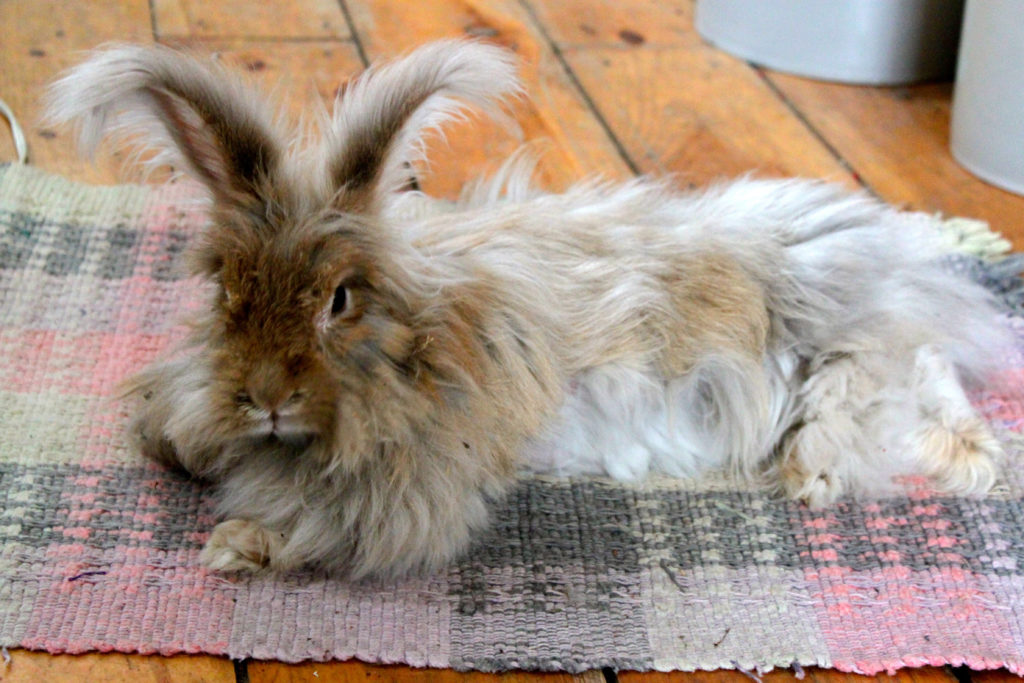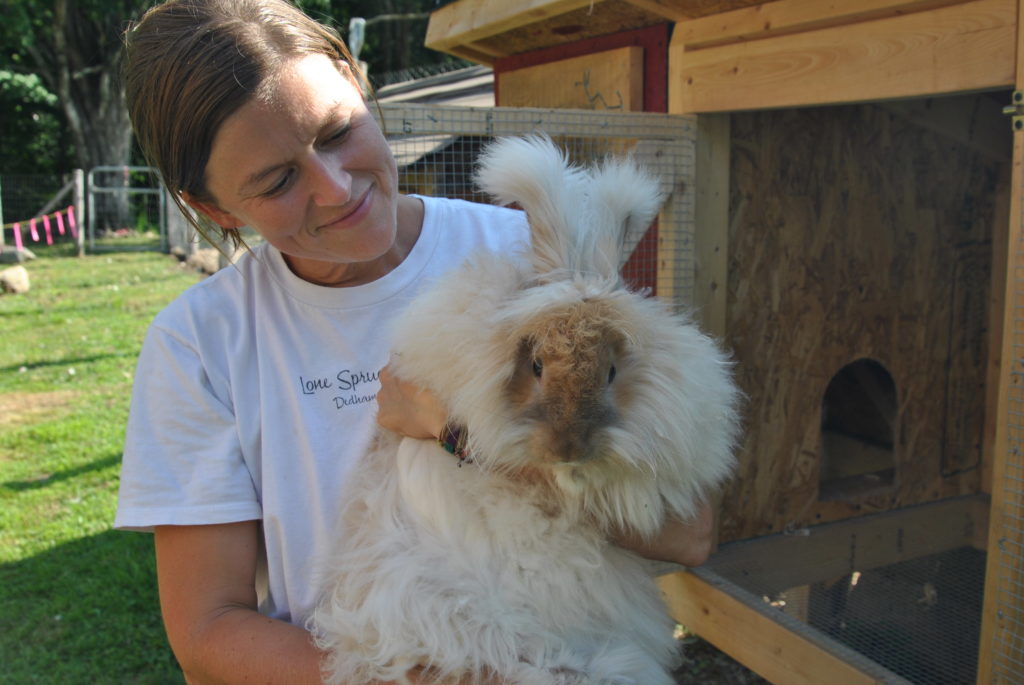The basics of raising angora rabbits for wool

Angora rabbit wool is prized for its silkiness and warmth. Raising your own Angora rabbits for wool can not only elevate your personal spinning and knitting projects, but it can also be fairly lucrative.
“[Angora rabbits] will produce more wool per bunny for less amount of feed and care than any other fiber animal,” said Jenny Smith, owner of Underhill Fiber Farm at Gorham, Maine. “Angora rabbits produce 1 to 4 pounds of wool a year for the space of a three-foot cage [and] 60 bucks a year to feed it.”
Angora rabbit wool will also fetch a higher price than the wool from many other fiber animals.
“Good quality angora is about $10 an ounce straight off the rabbit,” Smith said. “Sheep wool is $10 to $30 a pound, then you lose some when you wash it.”
There are 16 ounces in a pound.
Plus, harvesting wool from Angora rabbits is easier and less intense than it is for other fiber animals.
“You just set the rabbit in your lap,” Smith said. “For a sheep, unless you have a strong back and heavy clippers, you have to hire somebody.”
Whether you want the softest scarf in town or are looking to make some extra money on your homestead, here are the basics of what you need to know about raising Angora rabbits for wool.
Which Angora rabbit should I buy for wool?
If you are new to raising rabbits, Smith said that one Angora rabbit is plenty to start.
“That’s enough for a sweater, hat and scarf,” Smith said. “They’re productive.”
There are five Angora rabbit breeds used for fiber production: English, French, Satin, Giant and German Angoras. Other rabbit breeds, such as the Jersey Wooly and the American Fuzzy Lop, also produce wool, but the small breeds are significantly less productive and generally only used by hand-spinners.
The German Angoras are the most productive fiber-producing breed, generating between three-quarters and a pound of wool every year.
“You shear [German Angoras] four times a year,” Robin Ford, co-owner of Growing a Rabbit Tree rabbitry in Newcastle, Maine. “They get used to sitting still, and they enjoy it in the summer.”
English and French breeds, however, do not require shearing at all — their wool can be plucked.
Smith raises French-German Angora cross-breeds and asserts that the combination is ideal for wool production.
“The French Angora has a very low production of wool, but they [are] easy maintenance [because they are] not prone to matting at all and come in a huge number of colors,” Smith explained. “By crossing the two, we lose some of our fiber quantity, but we gain the color and easy care.”
Angora rabbit care

Though Smith said most aspects of Angora rabbit care are similar to that of other breeds, Angora rabbits are slightly more high-maintenance than their less-fluffy counterparts. For example, Angora rabbits require grooming between shearings.
“Good quality angora rabbits that have been bred for wool production require grooming once a month or less,” Smith said. “If your bunny needs to be groomed every day, there is something wrong with it — either bad genetics, or a bad environment.”
Between shearings, Smith said to trim the wool “around their boy and girl parts and behind their ears.” Ford also said to clip the wool around their “cheeks and cheeks:” around the face and derriere.
Smith said you can use a special blower to straighten the fur and lift dander and dust off the skin, which is especially effective for angora rabbits with dense coats.
Never bathe Angora rabbits, though. In fact, Smith said to touch and handle the rabbit as little as possible.
“Rabbits are like cats — they keep themselves clean,” Smith said. “The more you touch the rabbit, the more the rabbit is going to clean itself and risk ingesting wool and dying. They’re working rabbits, not pet rabbits.”
Because of their long wool, Angora rabbits are susceptible to a condition called wool block, which can be fatal.
“They get hairballs like a cat, but they cannot throw up, so they ingest it or goes into their intestines,” she said.
Ford added that Angora rabbits are also susceptible to tiny, biting wool mites.
“You can treat miles with a shot, which depends on their weight,” Ford said. “[On the bright side,] they don’t usually have worms.”
Smith also recommended providing each of your Angora rabbits with their own cage.
“They don’t like to share cage space,” she warned. “Most of them try to kill each other when they share cage space.”
Sometimes, though, Smith said that rabbits may die despite your best efforts.
“[Rabbits] have a life expectancy of 30 seconds to 12 years,” Smith said. “They don’t tell you when they’re sick. They just drop dead. It’s not always what you did wrong — it’s just that rabbit.”
Marketing Angora rabbit wool
Angora fiber can be sold spun, dyed or left its natural color. Because Angora rabbit wool is extremely warm and not naturally elastic, blending the fiber with other kinds of wool, mohair or cashmere will help make the fiber more marketable.
“Sheeps’ wool is the best,” Smith said. “It has memory and bounce.”
Smith said the best way to sell Angora rabbit wool is to spin and knit with it yourself.
“That’s the best way to market something — by talking about how wonderful it is,” she said. “Then you’ll find people who want to buy it.”
There are a number of distribution channels to sell Angora fiber. Ford sells her Angora rabbit wool wholesale to the Aroostook Fiber Mill.
“I have a full-time job in addition to this,” Ford said. “It’s sort of my passion project.”
If you have the time, though, Smith recommended finding personal distribution channels.
“Wholesale is not worth it,” Smith said. “A hand spinner at local fair will pay [more].”
For that reason, making the effort to seek out your market at fairs and craft events can be essential to successfully making a profit on your Angora rabbits.
“The people who really want to buy it are going to be there,” Smith said.
Smith said that some farmers and homesteaders will also raise Angora rabbits for meat and showing in order to maximize the potential profit from their working rabbits.
“They’re dual purpose,” Smith said. “Angora rabbits are very cost effective for your use.”
